Harley-Davidson's New Adventure Motorcycle Is Truly One of a Kind
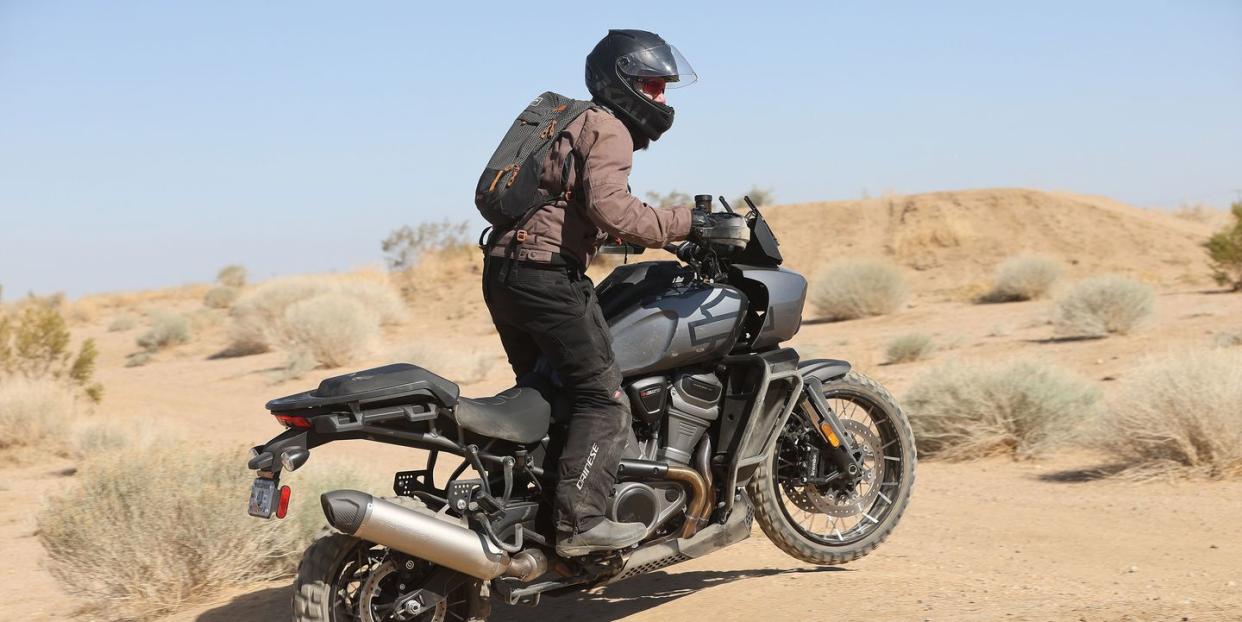
Two seconds. That's about how long I had to think when my colleague, Will Sabel Courtney, forwarded me an email with his own one-word addition: "Intrigued?" The email itself was an invitation to test ride Harley-Davidson's potentially game-changing adventure touring motorcycle, the Pan America 1250 Special, in the Mojave Desert.
My almost-immediate response, for the record: "Whoa yeah for sure."
A month later, I found myself amidst the joshua trees at Zakar, the California branch of RawHyde Adventures, a fresh-faced student of both off-road motorcycling and this bold new Harley. Thankfully, the brand had teamed up with this adventure touring and training company (founded, fittingly, by a guy named Jim Hyde) to host several media members at their desert encampment and teach us how to ride these bikes.
The agenda? An evening learning all about the bike, a daylong off-road clinic, and then, the real test: a 150-mile road ride highlighted by a bunch of twisties and a not-inconsiderable 15-mile stretch of pure off-road riding, climbing and descending a winding road covered in dirt and rocks and the most precarious surface of all: sand.

As most of the media present were people who primarily write about motorcycles, I was easily the greenest of the group. But in some ways, that makes me the perfect focus group for the Pan America. It's Harley's first foray into adventure motorcycles, and the brand did not take the challenge lightly. The team took every conceivable step to make a bike that's approachable for not only diehard Harley cruiser fans, but also seasoned adventure bike riders and perhaps the toughest-to-reach segment: vertically challenged off-road noobs like yours truly.
See, more than any other type of motorcycle, adventure bikes are tough for the less-long-legged among us, because you can't go off-road without substantial clearance to ride over obstacles. But spoiler alert: thanks to a combination of top-notch coaching and very well thought-out design, I survived! Looking back, here's what stands out about this bold new beast of a bike.
The Pan America looks like no other Harley
Let's be honest: Jax Teller would turn over in his grave if you told him this bike was a Harley-Davidson. Though the brand obviously makes a wide range of bike, its long and storied history feels pretty rooted in classically styled cruisers.
This bike is most definitely not that, but interestingly, it's not some clone of the BMW GS or Honda Africa Twin either. One aesthetic the designers were pretty adamant about was "no beaks," which pretty quickly distinguishes it from the best-known bikes in the segment — and gives it a more muscular, utilitarian look.

Another guiding principle Harley stuck to was an iconic V-twin engine as a central feature, which is why if you zoom in on the side of the bike, it is unmistakably a Harley.
The engine actually makes functional sense (more on that later), and while I'm sure the appearance will have its haters amongst both the Harley and adventure touring communities, I happen to think the thing looks pretty damn cool.
Harley's all-new engine is no joke
Yes, it's got that classic V-twin shape, but Harley didn't just pull something out of one of its other bikes and plop it into this one. No, the liquid-cooled Revolution Max 1250 Engine was specifically designed to be an off-road rock star.
Key traits include smooth low-end torque delivery and low-speed throttle control, which are essential to safely navigating over and around off-road obstacles. The V-twin shape, conveniently enough, also centralizes mass to optimize the bike's balance and handling.
The engine also features internal balancers to reduce vibration. The rumble reduction may not be ideal for branding — there's a reason they say nothing sounds like Harley — but as I learned in the desert, you can do plenty of bouncing around on dirt trails without any help from the engine.
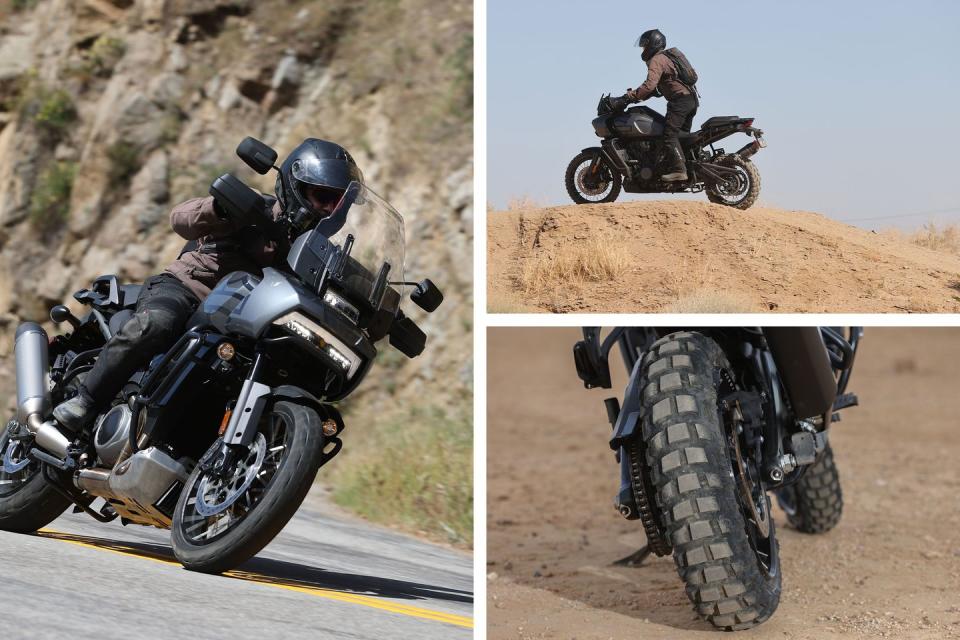
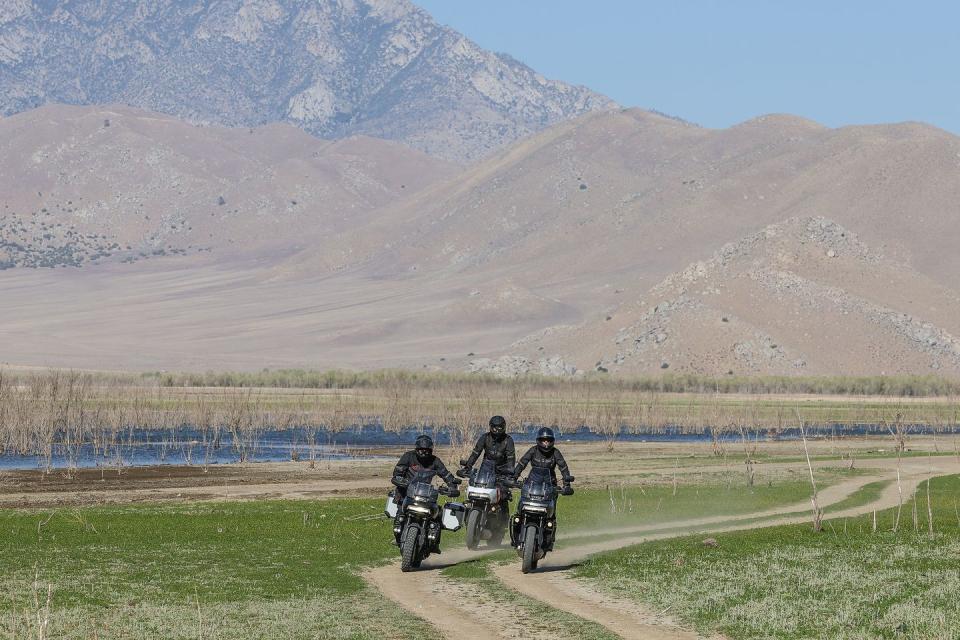
Another departure from Harley's typical design is a chain final drive rather than a belt drive, but that is de rigeur for the adventure touring segment and easier to repair in the field.
It's worth noting are that Harley took pains to not only optimize performance but minimize weight. The result is that a fully fueled base model Pan America 1250 ($17,319) weighs just 534 pounds, while the 1250 Special ($19,999) that I tested weighs 559. The former is 25 pounds lighter than a base model GS, which helps not only on the highway but when, say, you happen to drop it in the dirt. (Believe me, I now know from experience.)
Just about everything on this adventure bike is adjustable
In its determination to make the Pan America accessible to the widest possible range of riders, Harley zeroed in on a critical characteristic: adjustability. Here are just a few of the fun things you can tweak without spending an additional dime:
Ride Modes
The bike features five pre-set modes you can toggle through to find the one that best suits the riding conditions and your own desires: Sport, Road, Rain, Off Road and Off Road Plus. (That last one is for more aggressive and experienced off-roaders, as it disables rear wheel ABS, disables the linked braking function and disables cornering enhanced drag-torque slip control, effectively shutting off autopilot and giving you the most control.)
These modes each pack their own combo of power delivery, engine braking, ABS, traction control and, in the 1250 Special, suspension settings. You can also use any of these modes as a jumping-off point to program a custom mode or create one entirely from scratch. And you can do it all at the touch of a button, meaning you literally switch from Road to Off Road as your bike is rolling from the street to the wilderness.
Windshield
That's right, the windshield can be shifted to four different positions to accommodate stature, preference and changing environmental conditions.
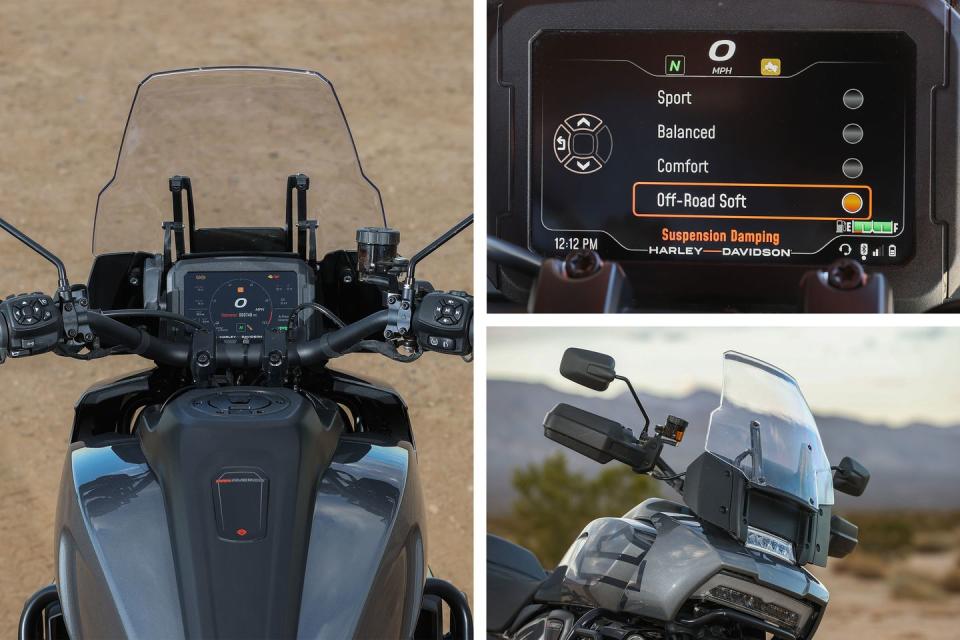
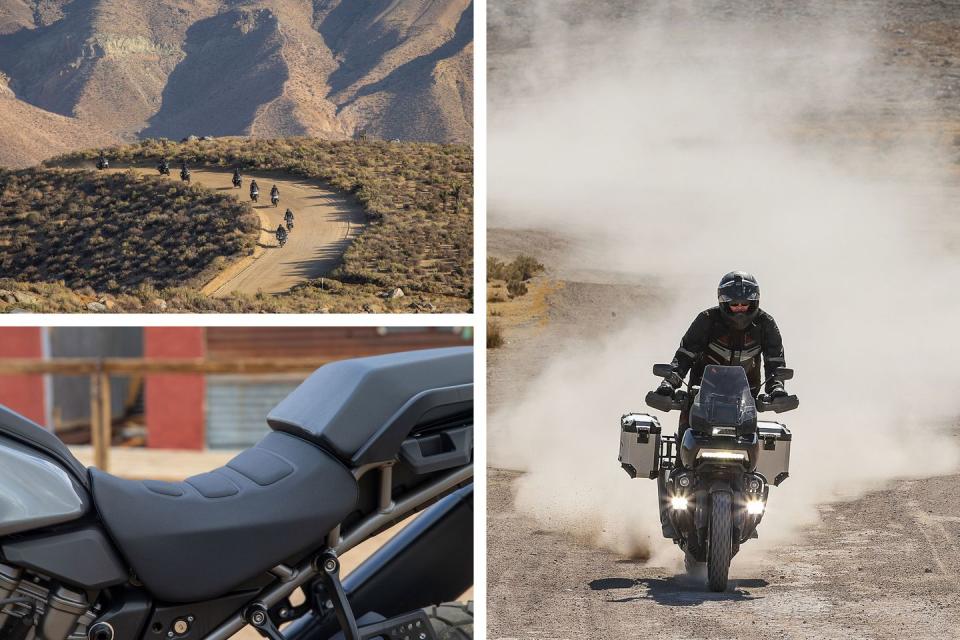
Rear brake foot pedal
You can kinda pull out this pedal and flip it over to change its height to improve control and comfort while standing, which I quickly found you do like 95 percent of the time when riding off road. And it's not just to look cool: it gives you optimal control and balance and enables you to fully counter steer — sticking your butt out to the right when you are turning left, for example, to keep the shiny side up.
Touchscreen
The 6.8-inch TFT touchscreen tilts on a mount for an adjustable viewing position. You can also add "widgets" to the screen to see whatever data you would like to have handy, such as turn-by-turn directions, trip meter info, or the music you are listening to through your Bluetooth-enabled mobile device.
Adaptive ride height
This first-ever technology is the coup de grâce — and truly a game changer for shorter riders. The electronic suspension automatically transitions from a low stopped position to optimal ride height when the bike is in motion. Seriously. Like some sort of mechanical camel, the bike lowers one or two inches as you come to a stop, enabling the inseam-challenged among us to get our feet more firmly on the ground.
The timing of this feature can be adjusted, and it can even be deactivated for taller riders or for extended off-road riding when you still want full height/clearance at low speeds.
The Pan America is optimized for safety
I realize that little header probably sounds like an oxymoron. Off-riding is inherently dangerous, considering the fact that beginners like yours truly will invariably dump the bike and be thrown from it — albeit at a lower speed than you'd be going on the highway, but still.
That being said, Harley has taken just about every conceivable step to make the bike as safe and user-friendly as possible. These steps include features like cornering enhanced linked braking, cornering enhanced traction control and drag-torque slip control, which combine to sort of cover for your mistakes and stay upright.
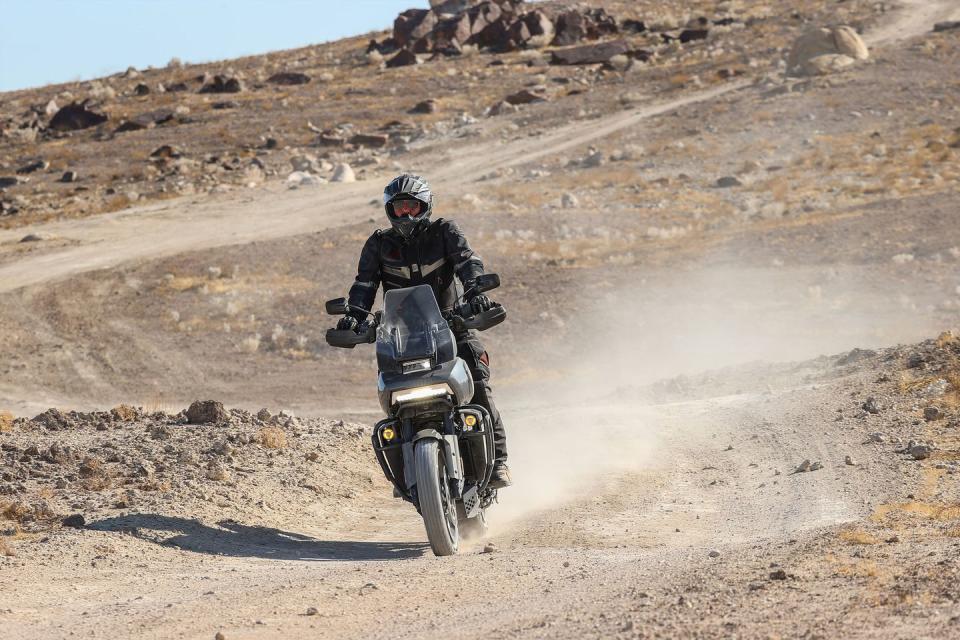
The Pan America also has a relatively new Harley feature: Hill Hold Control. When you need to stop on a hill, just apply a bit of extra pressure to the front or rear brake once you've stopped, and the bike will autonomously apply and hold brake pressure when you let out the brake and clutch and start moving again.
In other words, even on a really steep hill, you won't have that uncomfortable moment of rolling backward until you've given the bike enough gas to accelerate forward.
Once you get the hang of it, the Pan America is just so damn fun
Now that I've dished on the Pan America's most outstanding features, just one big question remains: what's it actually like riding the thing? And the answer, for this off-road neophyte, is obviously unlike anything else — and mostly in a good way. I definitely had my struggles with it, but in general this bike succeeds in the major goal of being approachable to people like me — and possibly you.
A couple of quick beefs before I go into more detail on the riding experience. If you're both vertically challenged and new to off-road riding, you may still find it challenging. Jim Hyde told us at the very beginning that dropping the bike was nothing to be ashamed of, and something we should not sweat. But I think I set a record for dropping mine...and half the time, it was while stopping as I struggled to get the tips of my toes on solid ground. I'm 5'8" on a good day, and I'm sure after a few days on the bike I would be comfortable one-footing around on this 31-inch seat, but that first day was tough.
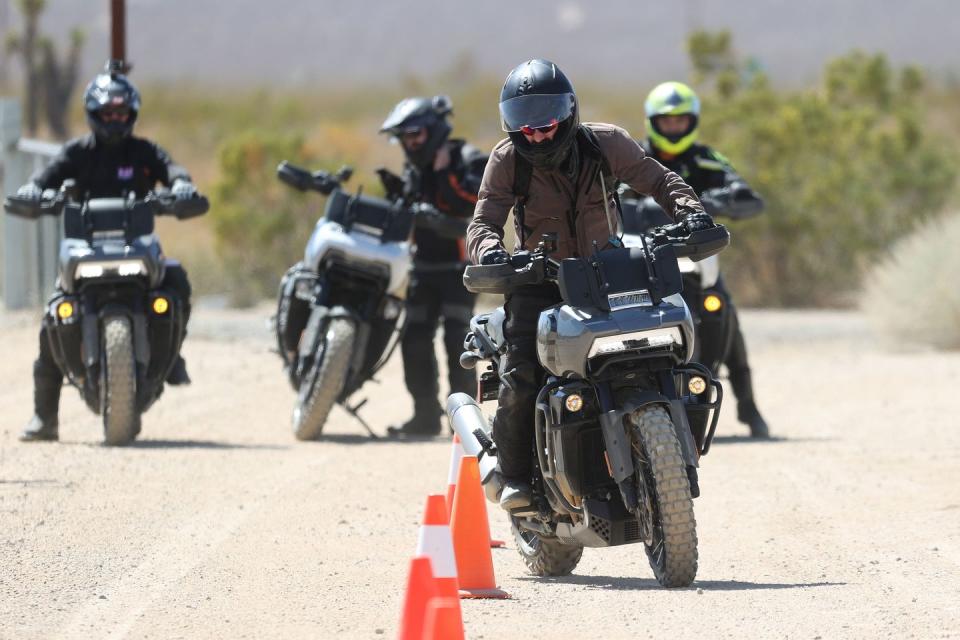
On a related note, the handlebars have these smartly designed plastic breakaway hand guards, which partially detach upon impact rather than breaking. They can be easily snapped back on, which is cool. However, another part doesn't break away, it simply breaks: the clutch and shift levers. By the end of the first day, I'd broken the tips of both of mine off. To be fair, they still worked perfectly fine, and the wonderful Harley staffers had brand-new ones in place for me the next morning (those, for the record, I did not break). But if you're a beginner and such a fate befalls you, well, you're not alone.
In the grand scheme, though, these are pretty minor quibbles — especially when weighed against how friggin' awesome and fun this bike is. Despite some early gaffes and boneheaded drops, by the end of the training day I was feeling pretty confident astride my steed — so much so that when the more skilled and experience media members capped things off by hitting a little motocross course at the end of the day, I cruised over there myself. Travis Pastrana I was not, but I navigated the whoops, banked turns and hills with I dare say considerable aplomb.

And when the Harley staffers swapped out the knobby tires for more road-ready ones the next day, I found the Pan America to be a more than capable highway ride. I enjoyed switching from road to sport mode when we hit the twisties, and the bike definitely responded. The handling and braking were perfect, the acceleration was zippy and the seat was perfectly comfortable for extended riding.
Later, when we hit the big offroad stretch, my throat was as dry as the desert. But I stood up on the pegs, stayed loose and flexible, and all the aforementioned features teamed up to ensure the bike remained stable as we climbed and descended a series of hills and valleys laden with tricky switchbacks, loose gravel, dirt, rocks and sketchy sand. Keeping two fingers on front brake and two on the clutch, I was able to adjust speed and counter steer and most importantly not drop the bike.
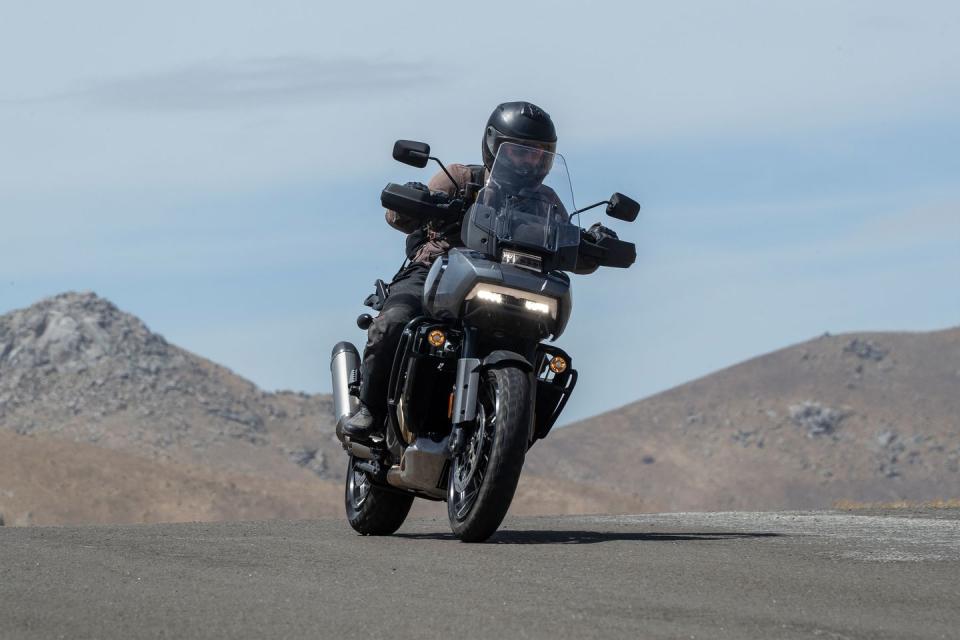
By the end of the offroad section, I was truly enjoying the freedom that comes when you don't need an actual road to ride. It's incredible to depart from the pavement and soak up the desert scenery as the sun beats down, the dirt kicks up and you become one with a machine that is optimized for letting you go your own way. The experience was equal parts empowering and exciting — and I can only close by saying that if perchance you are similarly intrigued by the prospect of checking out the Pan America, I hope you'll also say, "whoa yeah for sure" and gear up for the off-road ride of your life.
2021 Harley Davidson Pan America 1250 Special

Base Price: $19,999
Engine: Liquid-cooled Revolution Max 1250
Transmission: 6-speed manual
Horsepower: 150 / 112 kW @ 9000 rpm
Torque: 94 ft-lb
EPA Fuel Economy: 46 mpg
You Might Also Like

